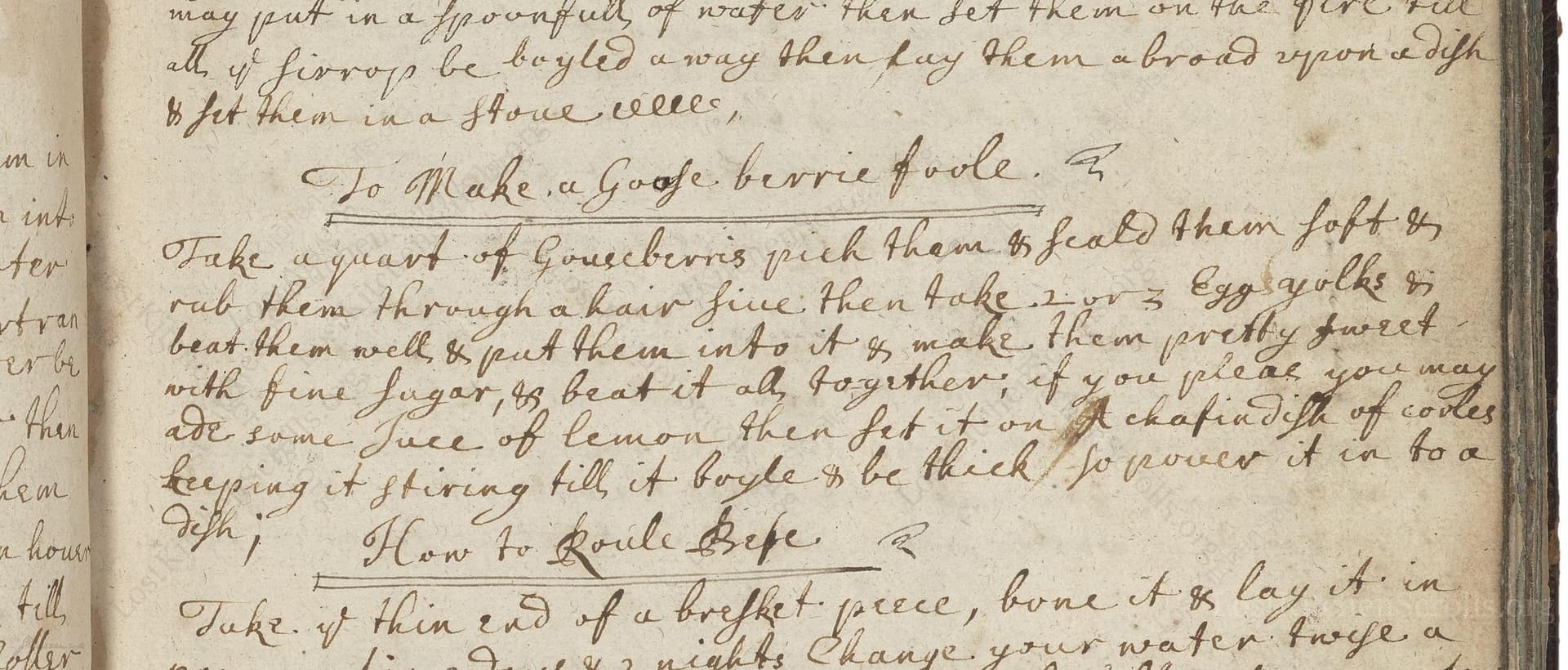To Make A Googe Berry Foole
From the treasured pages of Cookbook of Jane Dawson
Written by Jane Dawson

To Make A Googe Berry Foole
"Take a quart. of Goosberrys pick them & Scald them Soft & rub them through a hair fine. then take 2 or 3 Egg. yolks & beat them well & put them into it & make them pretty Sweet with fine Sugar, & beat it all together; if you pleaſe you may adde Some Iuce of lemon then Set it on a chafingdish of coles Keeping it Stiring till it boyle & be thick, So pouer it in to a Dish;"
Note on the Original Text
The recipe is written in the practical, telegraphic style of 17th-century manuscript cookbooks, assuming the reader understands basic kitchen processes and omitting measurements or specifics considered self-evident at the time. Spelling and punctuation are irregular ('Iuce' for 'juice', 'boyle' for 'boil', and 'Stiring' for 'stirring'), with words run together and uncommon use of capitalization. Ingredients are introduced as actions, and quantities are imprecise, meant for adjustment according to taste or household needs.

Title
Cookbook of Jane Dawson (1690)
You can also click the book image above to peruse the original tome
Writer
Jane Dawson
Era
1690
Publisher
Unknown
Background
A delightful glimpse into late 17th-century English kitchens, Jane Dawson's recipe collection is a flavorful tapestry of sweet delicacies and savory dishes, revealing the tastes and ingenuity of bygone home cooks.
Kindly made available by
Folger Shakespeare Library
This recipe originates from the late 17th-century manuscript of Jane Dawson. Gooseberry fool was a popular English pudding, enjoyed in the summer months when gooseberries were in season. It reflects a time when sugar was expensive and used to preserve tart fruits, and the process of making 'fool' (from the French 'fouler', to crush or press) was a clever way to blend fruit with rich, custardy ingredients for a luxurious dish. Manuscript cookery collections such as Dawson's were often kept by gentry households or skilled housewives, reflecting the domestic culinary practices and favored recipes of the English elite.

In the 17th century, this recipe would have been prepared using a chafing dish set over hot coals, as a controllable heat source for delicate cooking. A fine hair sieve was used to pass the gooseberries and ensure a smooth purée. Wooden spoons for stirring, simple ceramic or metal mixing bowls, and earthenware dishes for serving would all be typical. Precise temperature control was achieved by moving dishes closer or further from the coals.
Prep Time
10 mins
Cook Time
20 mins
Servings
4
We've done our best to adapt this historical recipe for modern kitchens, but some details may still need refinement. We warmly welcome feedback from fellow cooks and culinary historians — your insights support the entire community!
Ingredients
- 1 1/2 lbs gooseberries (fresh; if unavailable, substitute frozen or tinned gooseberries, well drained)
- 2-3 egg yolks (large)
- 1/3 to 1/2 cup caster sugar (to taste)
- Juice of half a lemon (optional)
Instructions
- To make a gooseberry fool, start by taking 1 1/2 pints of fresh gooseberries (about 1 1/2 lbs) and removing their stems and tops.
- Place the gooseberries in a saucepan and add just enough water to barely cover them.
- Gently heat until the berries are soft and begin to burst, then mash or pass them through a fine sieve to create a smooth purée.
- In a bowl, beat together 2 or 3 large egg yolks.
- Add these to the puréed gooseberries and mix well.
- Stir in about 1/3 to 1/2 cup of caster sugar, adjusting to taste for sweetness.
- For extra brightness, squeeze in the juice of half a lemon if desired.
- Transfer the mixture back to the saucepan and gently heat over low to medium heat, stirring constantly, until the fool thickens and just reaches a gentle boil—it should have the texture of a loose custard.
- Do not let it scramble.
- Once thickened, pour the fool into a serving dish and let cool before serving, either at room temperature or chilled.
Estimated Calories
180 per serving
Cooking Estimates
You will spend about 10 minutes preparing the gooseberries and ingredients, and about 20 minutes cooking everything together. Each serving contains about 180 calories, and this recipe makes 4 servings.
As noted above, we have made our best effort to translate and adapt this historical recipe for modern kitchens, taking into account ingredients nowadays, cooking techniques, measurements, and so on. However, historical recipes often contain assumptions that require interpretation.
We'd love for anyone to help improve these adaptations. Community contributions are highly welcome. If you have suggestions, corrections, or cooking tips based on your experience with this recipe, please share them below.
Join the Discussion
Rate This Recipe
Dietary Preference
Main Ingredients
Culinary Technique

Den Bockfisch In Einer Fleisch Suppen Zu Kochen
This recipe hails from a German manuscript cookbook compiled in 1696, a time whe...

Die Grieß Nudlen Zumachen
This recipe comes from a rather mysterious manuscript cookbook, penned anonymous...

Ein Boudain
This recipe comes from an anonymous German-language manuscript cookbook from 169...

Ein Gesaltzen Citroni
This recipe, dating from 1696, comes from an extensive anonymous German cookbook...
Browse our complete collection of time-honored recipes



